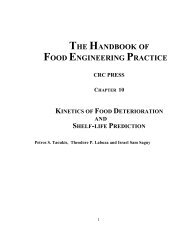A combined discreteâcontinuous model describing the lag phase of ...
A combined discreteâcontinuous model describing the lag phase of ...
A combined discreteâcontinuous model describing the lag phase of ...
You also want an ePaper? Increase the reach of your titles
YUMPU automatically turns print PDFs into web optimized ePapers that Google loves.
178 R.C. McKellar, K. Knight / International Journal <strong>of</strong> Food Microbiology 54 (2000) 171 –180<br />
<strong>the</strong> tL<br />
is independent <strong>of</strong> cell number. The substance limited fitting <strong>of</strong> <strong>the</strong> discrete–continuous <strong>model</strong> to<br />
<strong>of</strong> <strong>the</strong> present study was presented previously (McK- experimental data, and will form <strong>the</strong> basis <strong>of</strong> a later<br />
ellar, 1998).<br />
publication.<br />
The present study also reports, for <strong>the</strong> first time, Baranyi and Pin (1999) have also recently pro<strong>the</strong><br />
inclusion <strong>of</strong> a discrete step into <strong>the</strong> <strong>model</strong>ing <strong>of</strong> posed a method for calculating l and m from t<br />
d.<br />
bacterial growth; all o<strong>the</strong>r published <strong>model</strong>s are Their method is based on <strong>the</strong> biological interpretabased<br />
on continuous functions only. This improve- tion <strong>of</strong> <strong>the</strong> initial physiological state <strong>of</strong> <strong>the</strong> cells,<br />
ment is critical to <strong>the</strong> <strong>model</strong>ing <strong>of</strong> single cell where <strong>the</strong> suitability for growth is represented by a<br />
behavior during <strong>the</strong> adaptation period prior to initia- fraction <strong>of</strong> <strong>the</strong> initial cell population. This interpretation<br />
<strong>of</strong> growth, and is facilitated by <strong>the</strong> use <strong>of</strong> an tion is similar to <strong>the</strong> one suggested by McKellar<br />
object-oriented programing environment such as (1997) who attributed <strong>the</strong> potential for growth to a<br />
®<br />
ModelMaker . Individual-based <strong>model</strong>s (IBMs) sub-population <strong>of</strong> <strong>the</strong> inoculum. The Baranyi and Pin<br />
have been used extensively in ecological <strong>model</strong>ing approach uses an analysis <strong>of</strong> variance (ANOVA)<br />
situations (Grimm, 1999; Lomnicki, 1999), but have method to deal with variability <strong>of</strong> low cell populayet<br />
to be applied in food microbiology. Providing a tions to estimate a value for m. Values for tL<br />
are<br />
dynamic environment for <strong>the</strong> simulation <strong>of</strong> bacterial calculated using <strong>the</strong> m and <strong>the</strong> physiological state <strong>of</strong><br />
growth based on <strong>the</strong> use <strong>of</strong> differential ra<strong>the</strong>r than <strong>the</strong> inoculum. In <strong>the</strong> present study, values for m are<br />
explicit equations is also considered important for estimated using a wider range <strong>of</strong> dilutions than<br />
<strong>the</strong> future development <strong>of</strong> bacterial growth <strong>model</strong>s reported by Baranyi and Pin, thus minimizing <strong>the</strong><br />
(Baranyi, 1997). Common s<strong>of</strong>tware packages which influence <strong>of</strong> higher variance.<br />
are generally used for non-linear regression do not Buchanan et al. (1997) describe <strong>the</strong> <strong>lag</strong> <strong>phase</strong> by<br />
have this capability, thus <strong>the</strong> use <strong>of</strong> s<strong>of</strong>tware such as <strong>the</strong> following equation:<br />
®<br />
ModelMaker leads to <strong>the</strong> development <strong>of</strong> more<br />
tLag 5 ta 1 t<br />
m<br />
complex <strong>model</strong>s incorporating <strong>the</strong> multiple steps<br />
(5)<br />
involved in adaptation and growth.<br />
where ta<br />
is <strong>the</strong> time required for <strong>the</strong> cells to adapt to<br />
A <strong>the</strong>oretical <strong>model</strong> which accounts for <strong>the</strong> be- <strong>the</strong>ir new environment, and tm<br />
is <strong>the</strong> generation time.<br />
havior <strong>of</strong> individual cells has been suggested by The present <strong>model</strong> assumes that growth starts imme-<br />
Buchanan et al. (1997), who were <strong>the</strong> first to propose diately after <strong>the</strong> adaptation step, thus t (this study)<br />
L<br />
that <strong>the</strong> transition between <strong>lag</strong> and exponential is equivalent to t<br />
a.<br />
<strong>phase</strong>s resulted from biological variation among<br />
Baranyi (1998) has recently compared stochastic<br />
and deterministic concepts <strong>of</strong> <strong>the</strong> <strong>lag</strong> <strong>phase</strong>, and has<br />
suggested that <strong>the</strong> l is always less than <strong>the</strong> t<br />
L. This<br />
individual cells. These workers provided a <strong>the</strong>oretical<br />
basis for <strong>describing</strong> <strong>the</strong> <strong>lag</strong> <strong>phase</strong> in terms <strong>of</strong><br />
individual cells; however, <strong>the</strong>y proposed a simpler, seems reasonable, since increased S.D.<br />
L<br />
at constant<br />
three-<strong>phase</strong> <strong>model</strong> for general use which did not tL<br />
resulted in a shorter l in <strong>the</strong> present study (Fig. 7)<br />
account for inter-cell variation. The present <strong>model</strong> and also in <strong>the</strong> @RISK simulations reported by<br />
builds on this foundation by <strong>the</strong> addition <strong>of</strong> tur- Buchanan et al. (1997). It is intuitively obvious that<br />
bidimetric data which provides evidence for indi- l can only be equal to tL<br />
in <strong>the</strong> special case where<br />
vidual cell behavior, and incorporates this variability <strong>the</strong> cells all adapt simultaneously (e.g., S.D.<br />
L50). In<br />
into <strong>the</strong> <strong>model</strong> as a distinct parameter (S.D.<br />
L).<br />
<strong>the</strong> present study using simulated growth curves, l<br />
Buchanan et al. (1997) used <strong>the</strong> risk analysis s<strong>of</strong>t- was greater than tL<br />
when determined by <strong>the</strong> Gom-<br />
ware, @RISKE, to simulate <strong>the</strong> variability between pertz function, and identical to tL<br />
in one <strong>of</strong> two trials<br />
cells, but fit only <strong>the</strong> three-<strong>phase</strong> linear <strong>model</strong> to using <strong>the</strong> HPM. This may be due to <strong>the</strong> inherent<br />
error associated with estimations <strong>of</strong> l from fitting<br />
data with non-linear regression functions. It is also<br />
worth mentioning that nei<strong>the</strong>r <strong>the</strong> Gompertz nor <strong>the</strong><br />
HPM are intended for fitting data derived from<br />
distributions <strong>of</strong> individual cell properties, since nei-<br />
<strong>the</strong>r <strong>of</strong> <strong>the</strong>se <strong>model</strong>s can account for changes in<br />
curvature between <strong>lag</strong> and exponential <strong>phase</strong>s under<br />
experimental data. Since <strong>the</strong> present <strong>model</strong> contains<br />
a random number generator, it was not possible to fit<br />
experimental data using <strong>the</strong> optimization algorithms<br />
®<br />
in ModelMaker , thus optimization must be performed<br />
manually. It will be possible, however, to<br />
construct tables <strong>of</strong> distributions with varied S.D.<br />
L<br />
which can be read into <strong>the</strong> <strong>model</strong>. This will allow














